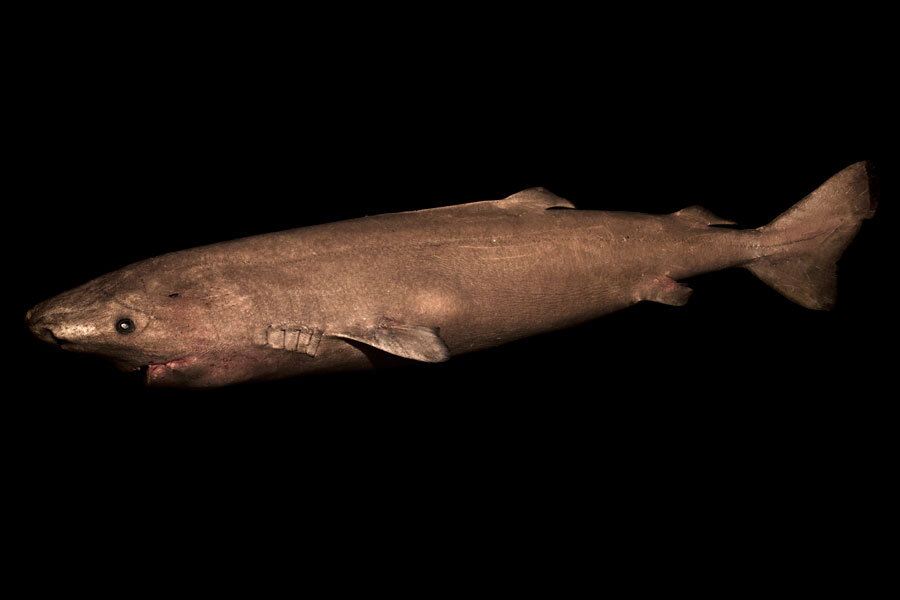Oldest vertebrate? Greenland sharks may live for 400 years, say scientists
Get Guinness World Records on the phone. Scientists say they've just found the "longest-lived vertebrate."
The Greenland shark, Somniosus microcephalus, probably can live about 400 years, according to research published Thursday in the journal Science. If the researchers are right, then those sharks knock out the bowhead whale, which can live for just over 200 years, for the vertebrate with the longest lifespan (although not the oldest animal).
That means that there could be some Greenland sharks swimming around out in the ocean that are older than the United States of America. One shark could have swum past Sir Isaac Newton, dodged submarines in both world wars, and "witnessed" the dawn of the nuclear weapons age.
"These are really, really old animals," Peter Bushnell, one of the study authors and a marine biologist at Indiana University South Bend, tells The Christian Science Monitor.
But not everyone is convinced the sharks can live as long as Dr. Bushnell and his colleagues claim.
"These sharks almost certainly are old," says Simon Thorrold, a biologist at Woods Hole Oceanographic Institution who was not part of the study.
But, he tells the Monitor, "I would be very surprised" if these sharks live 400-year-long lives, or even have the 272-year lifespan that the research team says is the low end.
Still, Dr. Thorrold says, "It doesn't really matter if they're living to 100 years or 400 years, they're living a long time." And that's long enough to demand attention from conservationists, even if the Greenland sharks don't make it into the Guinness Book of World Records.
Thorrold's caution comes from some assumption-based calculations the research team used to determine the Greenland shark's lifespan. "It's a really difficult thing to try and figure out," he says, because these sharks don't have the features usually used to determine the age of a fish.
Scientists usually look at calcified vertebrae or the otoliths (earbones) of a fish to see how long it's been swimming around. Those bones grow bands – much like tree rings – each season, making it easy for researchers to count the years an organism has been around.
But Greenland sharks don't have any banded bones. So the researchers tried a method typically used to date archaeological finds: radiocarbon dating.
When an organism grows, the radiocarbon that is in the atmosphere is recorded in its tissues. So if scientists can match the radiocarbon levels in the animal with a certain period of time, they can figure out when that animal was born. "It's like a little snapshot," Dr. Bushnell says.
The researchers actually radiocarbon dated the eye lenses of Greenland sharks in this study, as they are some of the first tissues to develop in the shark.
But, as Bushnell puts it, on such short timescales this technique is kind of "sloppy." That's because the composition of the atmosphere typically changes very slowly.
Fortunately for the researchers, something was happening in the mid-1950s that caused a big change: an arms race. The US and the Soviet Union were testing nuclear weapons. This led to a distinctive surge in atmospheric radiocarbon levels, which have become a sort of timestamp in the biology of animals born soon thereafter.
So when the research team looked at the radiocarbon levels in 28 Greenland sharks' eye lenses, they were able to say that the two with this distinctive "bomb pulse" signature were born after the early 1960s.
And by extension, those without that signal were older than the nuclear era.
But that still left 26 sharks with ambiguous radiocarbon signatures, so the researchers had to try something else to pin down their ages.
The team built a computer model based around two assumptions: that the sharks' length was linked to their age, and that the animals' growth slows down as they age. Adult Greenland sharks are 13 to 16 feet long. Based on these calculations, the researchers say the sharks live to be 392 years old, plus or minus 120 years.
"In looking over the data from this study, I believe their age estimates up to 200 years are plausible," Charles Cotton, a fisheries ecologist at Florida State University who wasn't part of the study, writes in an email to the Monitor. But, he adds, he is skeptical of the age estimates for the older individuals, particularly because of the large margin of error.
But Thorrold says it goes beyond the margin of error.
"Even though they have pretty wide error bars on those estimates, I think that even that is probably way underestimating the error," he says.
That's because linking size and age is oversimplifying what happens as an animal ages, he explains. Not all individuals grow at the same rate.
But the broad strokes are right, Dr. Cotton says. "I think these results suggest this is indeed a very long-lived species, and I look forward to more studies of this kind to shed more light and further refine what has largely been undocumented age and growth parameters for this species."
And whether or not these sharks set any records, animals with this kind of longevity are particularly sensitive to human impacts.
"I would hate for the overall message to get lost," Thorrold says. Because these animals are hanging around in the ocean for so many years, and because they reproduce at slow rates and older ages, pollution, fishing and other human activity can take a significant toll on the Greenland sharks.
"Everything we do on the planet eventually ends up in the ocean, affecting everything. And when you have a really long-lived animal, it just becomes a toxin accumulator," Bushnell says. And destroying the population of an apex predator can have a significant affect down the whole food chain.









